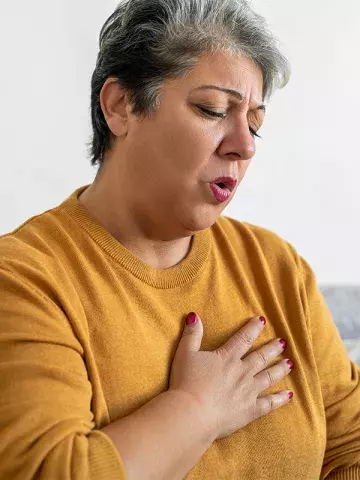Breathlessness in asthma: look for psychophysiological factors
By Rebecca Jenkins
Efforts to improve breathlessness in people with asthma should go beyond targeting airflow limitation and type-2 inflammation to prioritise psychophysiological factors such as body mass index (BMI) and physical activity, an Australian study suggests.
‘Breathlessness is a disabling symptom, with a complexity that is often under recognised and under treated in asthma,’ University of Newcastle-led researchers wrote in The Journal of Allergy and Clinical Immunology: In Practice.
To highlight the burden of breathlessness in asthma and to identify its psychophysiological correlates, the researchers conducted a cross-sectional observational study of 144 adults with mild-to-severe asthma (74 with mild-to-moderate asthma and 70 with severe asthma).
Participants, who were predominantly female (72%) with a median age of 63.4 years and a BMI of 31.3kg/m2, attended two in-person assessment visits within a two-week period at a single centre in Newcastle and completed a questionnaire pack between visits.
Researchers found 31% of people with mild-to-moderate asthma and 53% of people with severe asthma experienced physically limiting breathlessness, defined as a Modified Medical Research Council (mMRC) dyspnoea score of greater than 2, despite optimal pharmacotherapy.
Higher BMI and worse asthma control, exercise capacity and hyperventilation symptoms were identified as traits that predicted physically limiting breathlessness, the study found.
However, the asthma super-traits of airflow limitation and type-2 inflammation were poor predictors of breathlessness.
The researchers added that blood eosinophil and fractional exhaled nitric oxide levels were within relatively normal ranges for people with and without breathlessness.
‘The corollary of these findings is that ... targeting the super-traits of airflow limitation and type-2 inflammation alone is unlikely to be an effective strategy for achieving clinically significant relief of breathlessness for people with asthma,’ the researchers wrote.
‘Continuing to escalate therapies that target these traits based on measures of asthma control ... may lead to over treatment,’ they noted.
‘Targeting psychophysiological factors, or traits, associated with breathlessness may help relieve this distressing symptom, which is of high priority to people with asthma.’
Professor Christine Jenkins, Professor of Respiratory Medicine at UNSW Sydney and Program Head of Respiratory at The George Institute of Global Health in Sydney, said the study findings on airflow limitation and type-2 inflammation were important and unique.
‘We glibly assume that worse airflow limitation equates to being more likely to be short of breath,’ she told Medicine Today. ‘But this study shows the stronger determinants in this population are more behavioural (physical activity levels, BMI, breathing pattern disorder) and so should be addressed quite differently.’
Professor Jenkins urged GPs to be proactive and ask patients about breathlessness and assess symptoms objectively with a questionnaire such as the mMRC dyspnoea scale.
‘The take-home message is to manage dyspnoea in all asthma patients with guideline-directed medication/therapy, together with nonpharmacologic approaches that are most likely to help, such as addressing individual treatable traits: weight, physical activity and upper airway (vocal cord dysfunction) issues,’ she said.
Voice training and laryngeal hygiene techniques from a trained speech pathologist could be helpful for vocal cord dysfunction, she noted.
J Allergy Clin Immunol Pract 2024: doi: https://doi. org/10.1016/j.jaip.2024.06.019.


